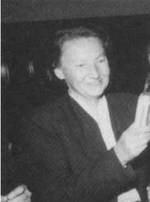


For a long time Elfriede Husemann was in the shadow of Hermann Staudinger, the founder of modern polymer chemistry. After his retirement, she took over the management of his institute at the University of Freiburg.
Elfriede Husemann was born on December 27, 1908 in Gütersloh. Her natural science talent was already evident at school and after graduating from the Auguste Viktoria School in Bielefeld, she enrolled in chemistry at the Albert Ludwigs University in Freiburg im Breisgau. In the autumn of 1929 she moved to Leipzig, where she studied with the physical chemist and later Nobel laureate in chemistry, Peter Debye (1884-1966).
After completing her intermediate diploma in the 1930 summer semester, she returned to Freiburg. Here she completed her doctoral thesis on magnesium compounds in 1933 under the guidance of Eduard Zintl (1898-1941). Since Zintl accepted a call to Darmstadt in the autumn of the same year, Hermann Staudinger (1881-1965) wrote the report on Husemann's dissertation. For her doctoral thesis and for the oral exams in the subjects of chemistry, physics and mineralogy, she received the grade ?very good? and the academic degree ?Dr. phil. nat. ".
From 1933 to 1946 Husemann worked as an assistant in Staudinger's laboratory, where she dealt with macromolecules. In October 1939 she completed her habilitation with a thesis on the structure of wood polyoses, those polymeric carbohydrates in wood that are now known as hemicelluloses. In Germany, Husemann was only the eighth chemist with a habilitation. Her two reviewers - Hermann Staudinger and Georg Wittig (1897-1987), who both later received the Nobel Prize for Chemistry - rated the habilitation thesis very positively, as Husemann had also dealt with new methods for characterizing high-polymer substances.
In the following years, Husemann's collaboration with the physician Helmut Ruska (1908-1973), a senior employee at Siemens & Halke AG in Berlin, proved to be extremely successful. Ruska is considered to be the pioneer of medical-life science electron microscopy. Husemann, in turn, used electron microscopy for the first time in polysaccharide research. Their pioneering work made electron microscopy a valuable instrument for the optical representation of macromolecules. Based on these studies, Staudinger's institute acquired an electron microscope in 1942, which Husemann took care of from then on.
Women in science had a hard time under the National Socialists, especially when, like Husemann, they did not belong to the NSDAP and did not want to join the party. The year 1942 nevertheless marked a career leap in the life of the now 33-year-old scientist. Due to the lack of teaching staff in the war years, she finally got a teaching position.
After the Second World War, in autumn 1945, Husemann helped rebuild the Chemical Institute in Freiburg. On Staudinger's recommendation, she was appointed adjunct professor in January 1946. Despite little financial resources, her research was crowned with success. In this way she was able to visually represent the polysaccharide amylopectin, the main branched component of plant starch, for the first time. Her work on the elucidation of the three-dimensional structure of amylose, the second main component of starch, also received special attention. In addition to carbohydrate research, another passion of Husemann should not go unmentioned: She was an enthusiastic motorcyclist. Your trips to the surrounding heights of the Black Forest are legendary.
Husemann turned down a call to Jena and stayed in Freiburg, although the faculty's application to set up an extraordinary office was delayed again and again - a typical problem faced by women scientists at the time, as Husemann put it. For a long time she was overshadowed by her ?father? Staudinger, who received the undivided Nobel Prize for Chemistry in 1953. After Staudinger's retirement in 1956, Husemann took over the management of his institute as an associate professor. It was not until 1962 that she was given the prestigious professorship for macromolecular chemistry at the Albert Ludwigs University in Freiburg. As a worthy successor to Staudinger, she expanded the Freiburg Institute into a modern center for polymer science. Her best-known students include Beate Pfannemüller (1920-2008), Walter Burchard (born 1930) and Helmut Ringsdorf (born 1929).
Numerous publications, especially on the chemistry of natural macromolecules, testify to Husemann's creative power and made it known far beyond the borders of Freiburg. For their findings in the strength of research she received in 1956 the Saare Medal, awarded by the Working Group of Cereal Research. In 1974 she retired.
Elfriede Husemann died of cancer at the age of 67. She died on November 9, 1975 in Freiburg.
a notice
The texts published in this series do not claim to be scientific publications. Authors and other people involved are not experts in the history of science. The purpose of the series is to introduce the mostly unknown women chemists and to remind you of the well-known women chemists. We encourage readers who want to know more to study academic Literature on the women featured. In some cases there are detailed chemical-historical works.
authors
Prof. Dr. Eberhard Ehlers
Prof. Dr. Heribert Offermanns
Editorial processing
Dr Uta Neubauer
project management
Dr Karin J. Schmitz (GDCh public relations)
The authors are responsible for the content of the biographies.
The content presented on these pages has been carefully compiled. However, the authors, Editorial staff and publishers assume no responsibility or liability for the completeness and correctness of the content or for typographical errors.
Photo: Nachr. Chem., 53 (2005) 1076.
back to overview biographies of women chemists
back to publications
This page has been machine translated. If you have any feedback or comments please feel free to contact us. 
last modified: 28.06.2021 11:59 H from K.J.Schmitz